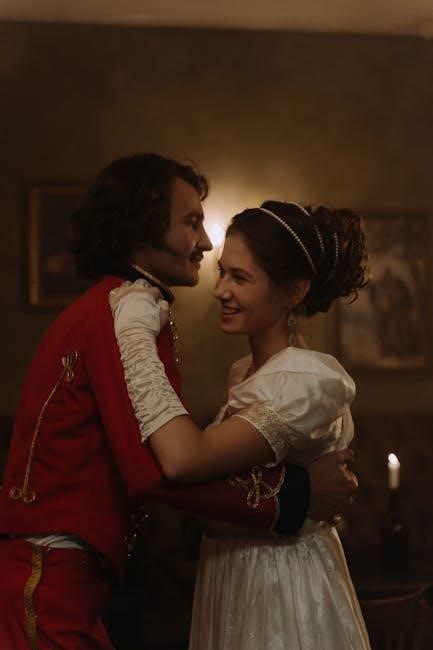
A Gentleman’s Guide to Love and Murder: A Comprehensive Overview
A Gentleman’s Guide to Love and Murder is a Tony Award-winning musical comedy based on Roy Horniman’s novel, following Monty Navarro’s quest to inherit an earldom through murder. With a blend of sophisticated music and dark humor, it balances elegance with outrageous comedy, charming audiences worldwide since its 2013 Broadway premiere.
A Gentleman’s Guide to Love and Murder is a Tony Award-winning musical comedy that masterfully blends wit, sophistication, and outrageous humor. Based on Roy Horniman’s 1907 novel Israel Rank: The Autobiography of a Criminal, the show follows Monty Navarro, a charming but disgraced nobleman, as he navigates a murderous quest to claim his inheritance. With its unique mix of dark comedy and elegant music, the musical captivates audiences with its clever storytelling and unforgettable characters. Since its Broadway premiere in 2013, it has become a standout production, earning widespread critical acclaim for its inventive direction, stunning costumes, and hilarious performances.
The Plot Summary
Monty Navarro, a charming nobleman, discovers he’s ninth in line to an earldom. He eliminates eight relatives, balancing ambition, love, and murder in a darkly comedic tale.
Monty Navarro’s Quest for Inheritance

Monty Navarro, a charming but impoverished nobleman, discovers he is ninth in line to the D’Ysquith earldom. Motivated by ambition and love for Sibella, he devises a plan to eliminate the eight relatives standing between him and the title. With cunning and wit, Monty systematically dispatches each obstacle, navigating a web of murder, romance, and societal expectations. His journey is a darkly comedic exploration of class, ambition, and the lengths one will go to for love and legacy.
The Obstacles: Eight Relatives in the Way
Monty Navarro faces eight eccentric D’Ysquith relatives, each posing a unique challenge. From the aging and ailing to the adventurous and stubborn, these characters showcase a range of personalities. Each relative’s death must appear accidental, testing Monty’s ingenuity and nerve. Their diverse traits highlight the dark humor of the plot, while their eliminations drive the story’s momentum. The relatives’ deaths, though comedic, underscore the ruthlessness of Monty’s ambition, making them both obstacles and catalysts in his quest for the earldom and love.

Balancing Love and Ambition
Monty Navarro’s journey is driven by both ambition and romance, as he navigates his desire for the D’Ysquith earldom and his love for two women: the vain Sibella and the kind-hearted Phoebe. While Sibella represents social climbing, Phoebe embodies genuine connection, creating a moral dilemma. Monty’s actions are fueled by his quest for status but tempered by his longing for love, showcasing a complex interplay between heart and ambition. The musical masterfully balances dark humor with emotional depth, highlighting Monty’s internal struggle to reconcile his sinister deeds with his romantic aspirations.

Historical and Literary Background
Based on Roy Horniman’s 1907 novel Israel Rank: The Autobiography of a Criminal, the musical explores themes of ambition and morality in early 20th-century society.
The Original Novel: Israel Rank by Roy Horniman
Roy Horniman’s 1907 novel Israel Rank: The Autobiography of a Criminal inspired the musical. It follows Israel Rank, a charming but ruthless man who murders his way to wealth and status. The novel’s dark humor and satirical take on British society laid the groundwork for the musical’s themes of ambition and morality. While the musical adapts the story to focus on Monty Navarro, the original novel remains a gripping tale of crime and social climbing, showcasing Horniman’s sharp wit and critique of class structures in early 20th-century England.
Adapting the Novel for the Stage
Robert L. Freedman and Steven Lutvak adapted Roy Horniman’s novel into a musical, infusing it with dark humor and satirical wit. They transformed Israel Rank into Monty Navarro, creating a more relatable antihero. The musical adds a comedic tone, with clever songs and a farcical approach to murder. While the novel is darker, the stage adaptation balances humor and sophistication, making it a unique theatrical experience. The creative team took liberties to enhance the story’s appeal, resulting in a Tony Award-winning production that blends music, comedy, and drama seamlessly.
Key Characters and Their Roles
Montague “Monty” Navarro is the charming antihero navigating murder and love. The eccentric D’Ysquith family stands in his way, while Sibella and Phoebe represent his romantic dilemmas.
Montague “Monty” Navarro: The Charismatic Antihero
Montague “Monty” Navarro is the charming and cunning protagonist who discovers he is eighth in line to the D’Ysquith earldom. Driven by ambition and love, Monty embarks on a murderous quest to eliminate his eight eccentric relatives, showcasing his wit and sophistication. His charisma and appeal make him a compelling antihero, as he navigates a delicate balance between his dark deeds and his romantic pursuits of Sibella and Phoebe. Monty’s journey is a blend of humor, morality, and intrigue, making him one of Broadway’s most memorable characters.
The D’Ysquith Family: A Lineage of Eccentric Characters
The D’Ysquith family is a dysfunctional aristocratic lineage filled with eccentric and colorful characters. Each relative is uniquely quirky, from the pompous Lord Adalbert to the overly dramatic actress Lady Hyacinth. Their exaggerated personalities and comedic flaws make them both memorable and targets for Monty’s clever schemes. The family’s eccentricities add a layer of humor and complexity to the story, while their collective demise drives the plot forward. Their roles highlight the clash between Monty’s ambition and their individual peculiarities, creating a dynamic interplay of wit and tragedy. Jefferson Mays’ portrayal of all eight relatives is a standout feature of the musical.
The Love Interests: Sibella and Phoebe
Sibella Hallward and Phoebe D’Ysquith are the two women vying for Monty Navarro’s heart, each representing different facets of his desires. Sibella, a vain and self-absorbed socialite, embodies the luxury and status Monty craves. Phoebe, kind-hearted and innocent, offers a genuine connection and moral grounding. Their contrasting personalities create a compelling dynamic, as Monty navigates his ambition alongside his romantic pursuits. Both characters are skillfully portrayed, with Sibella’s wit and Phoebe’s charm adding depth to the story. Their roles highlight Monty’s internal conflict between love and his ruthless aspirations, making them integral to the musical’s narrative. The actresses bring these characters to life with standout performances.
Creative Elements of the Musical

The musical blends music hall charm with operetta sophistication, featuring witty lyrics and a dynamic score. The direction masterfully balances dark humor with elegant Edwardian aesthetics, earning critical acclaim and numerous awards for its innovative storytelling and visual splendor.
Music and Lyrics: A Blend of Comedy and Sophistication
The musical features a sophisticated score by Steven Lutvak, with lyrics by Lutvak and Robert L. Freedman, blending music hall charm and operetta elegance. The witty, clever lyrics and catchy melodies effortlessly balance dark humor with refined musicality, creating a unique theatrical experience. The songs range from lively, comedic numbers to heartfelt ballads, showcasing the duality of Monty’s character and the absurdity of his situation. This innovative blend of comedy and sophistication earned the musical widespread critical acclaim and numerous awards, solidifying its place as a modern classic in musical theater.
Direction and Costumes: Bringing the Edwardian Era to Life
The musical’s direction masterfully captures the essence of the Edwardian era, blending vibrant staging with clever wit. The costumes, designed by Linda Cho, are a visual feast, featuring intricate period details that transport audiences to early 20th-century England. The opulent wardrobe reflects the characters’ social status, while the set design seamlessly transitions between grand estates and humble lodgings. The overall aesthetic is both refined and playful, perfectly complementing the story’s dark humor and sophistication. This attention to historical accuracy earned the production its Tony Award for Best Costumes, enhancing the immersive theatrical experience.

Reception and Accolades
A Gentleman’s Guide to Love and Murder garnered widespread acclaim, winning four Tony Awards and seven Drama Desk Awards. Its unique blend of comedy and music delighted both audiences and critics, solidifying its place as a standout production in the 2014 season.
Tony Awards and Critical Acclaim
A Gentleman’s Guide to Love and Murder triumphed at the 2014 Tony Awards, earning four prestigious wins, including Best Musical, Best Book, Best Direction, and Best Costumes. This made it the most-nominated show of the season. Critical acclaim praised its originality, witty dialogue, and standout performances. The New York Times hailed it as “murder most merry,” while audiences marveled at its dark humor and sophisticated score. The production also claimed seven Drama Desk Awards and four Outer Critics Circle Awards, cementing its status as a modern theatrical masterpiece.
Audience Response and Cultural Impact
Audiences adored A Gentleman’s Guide to Love and Murder for its unique blend of dark humor and charming wit. Theaters were filled with laughter as Monty Navarro’s antics captivated viewers worldwide. Its cultural impact was significant, revitalizing interest in musical comedies and inspiring new adaptations. The show’s success extended beyond Broadway, with productions in numerous countries, proving its universal appeal. Its clever storytelling and memorable characters left a lasting impression, making it a beloved classic in modern theater history.

The Legacy of A Gentleman’s Guide to Love and Murder
A Gentleman’s Guide to Love and Murder has left an indelible mark on Broadway and musical theater history. Its innovative blend of dark humor, sophisticated music, and intricate plot earned it a lasting reputation as a modern classic. The show’s success paved the way for future musical comedies, influencing creators to experiment with bold storytelling. Its Tony Awards and critical acclaim solidified its legacy, while its universal appeal continues to attract audiences worldwide. This musical remains a testament to the power of wit and charm in storytelling, ensuring its place as a timeless theatrical treasure.